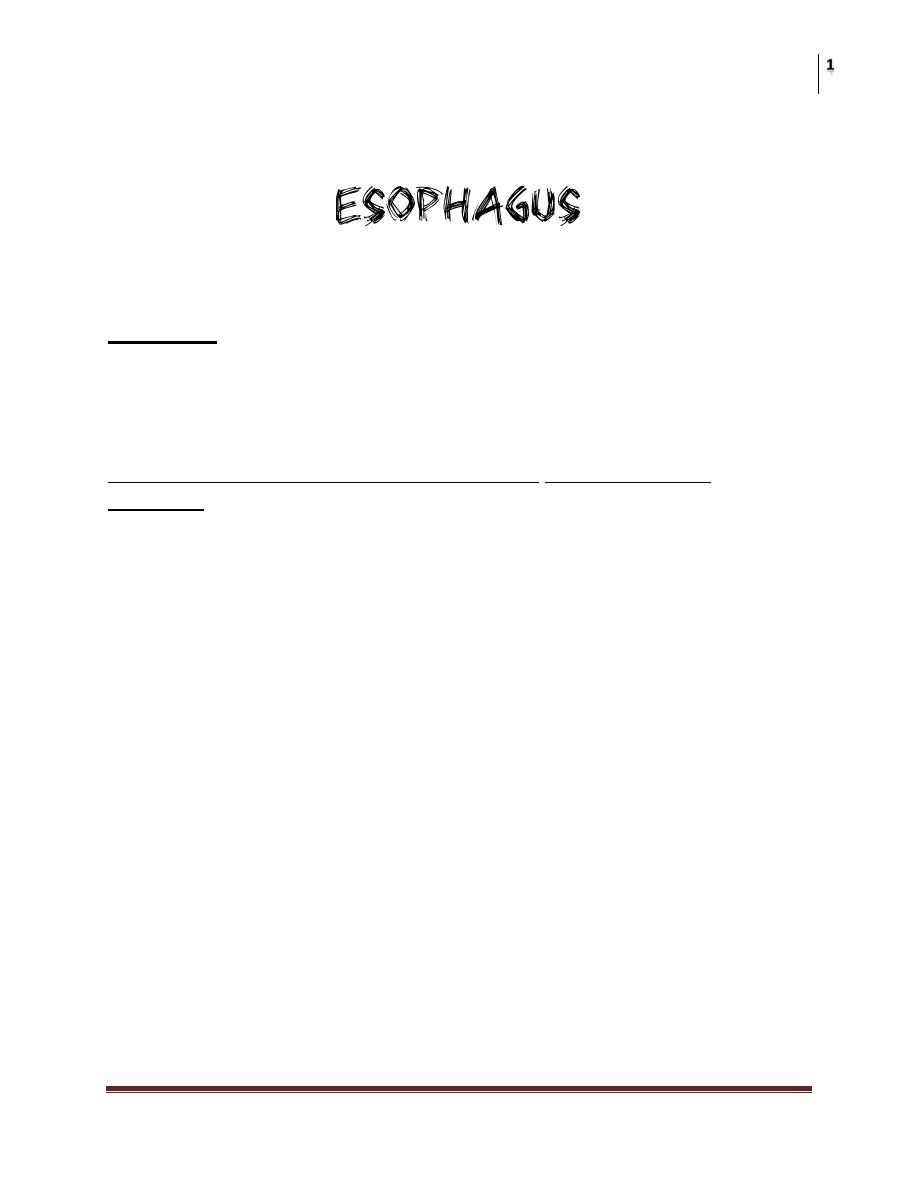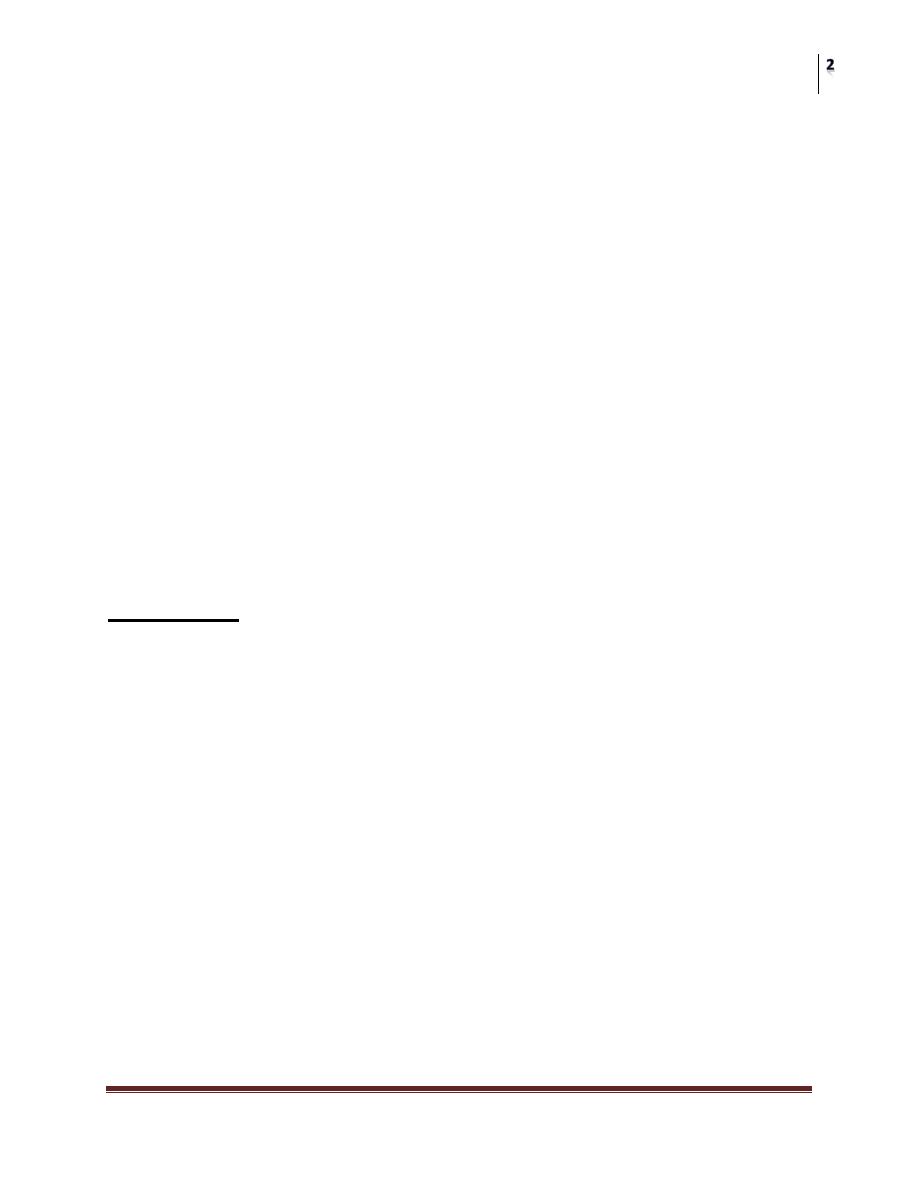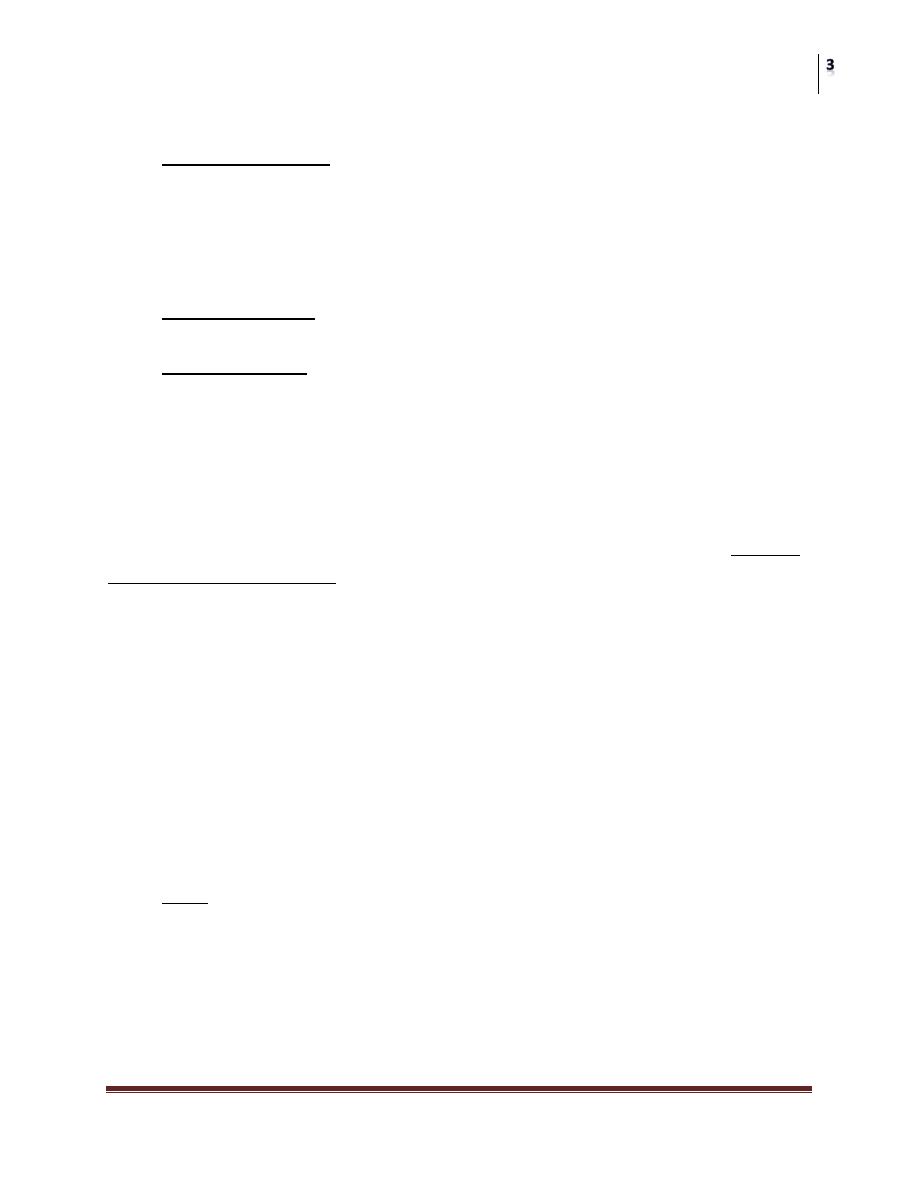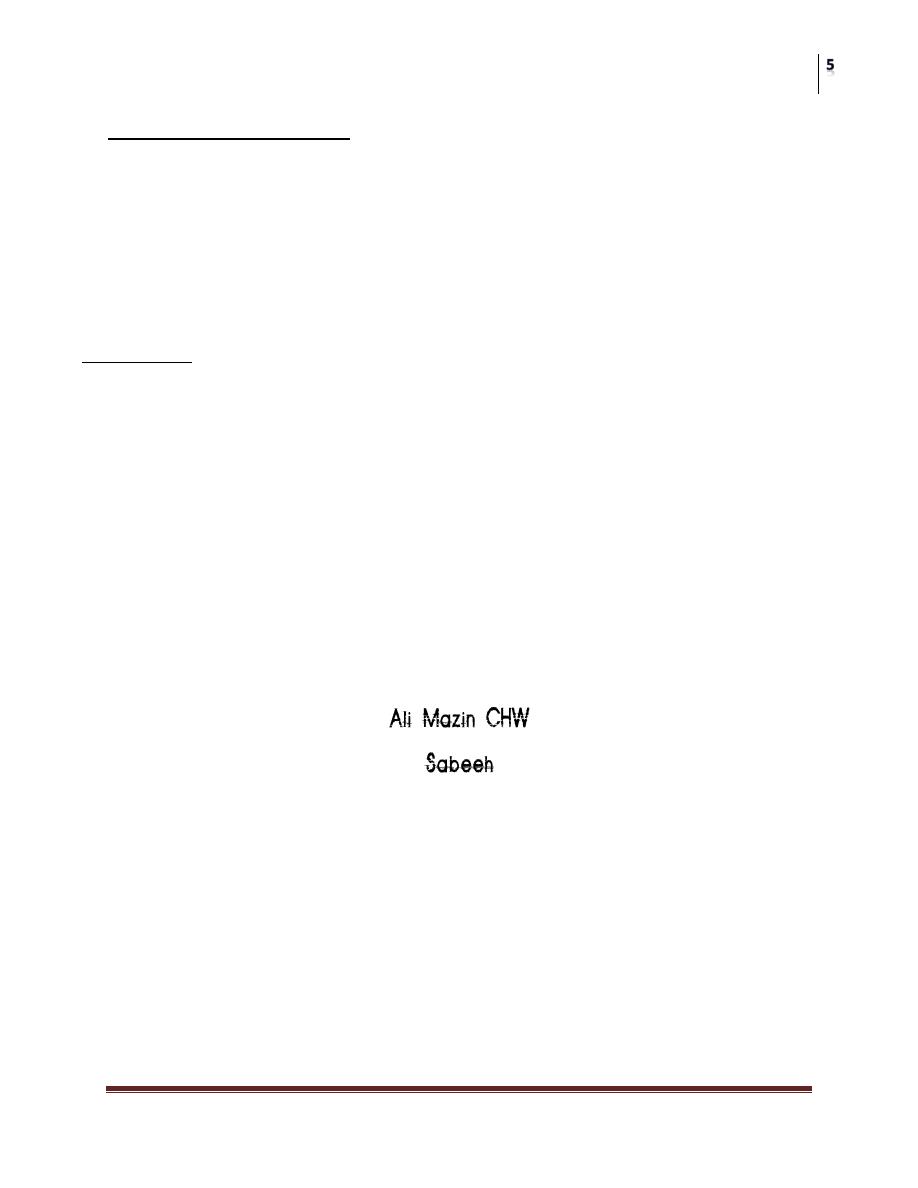
Surgery
Esophagus
Prof. Dr. Waleed Mustafa
Lec. 1
SURGERY
Prof. Dr. Waleed Mustafa
Lec.1
Anatomy:
The Esophagus is a long muscular tube approximately 40 cm from the incisor teeth
(25 cm from cricopharyngeus ),that extends from the pharynx at the level of 6
th
.
Cervical vertebra to the stomach, which it joins opposite the body of 11
th
. Thoracic
vertebra. It is arbitrary divided into Cervical, Thoracic and Abdominal parts.
The esophagus has three distinct areas of naturally occurring anatomic
narrowing:
1. The crico pharyngeal constriction
2. Broncho aortic constriction.
3. The diaphragmatic constriction .Between these areas the esophagus has a
wide caliber and is termed superior & inferior dilatation .
Blood supply: segmental
1. Cervical esophagus supplied by Inf. thyroid ar.
2. Thoracic esophagus - esophageal branches (Aorta)
Segmental vessels (intercostal &phrenic).
Abdominal (phrenic & left gastric)
Venous drainage: Cervical esophagus drain to inferior thyroid &vertebral V.
Thoracic esophagus drain to azygous & hemi azygous, Abdominal esophagus
drain to gastric veins.
Lymphatics: run longitudinally in the wall of the esophagus penetrating muscle
layers to reach regional lymph nodes. The flow of the upper 2/3 is upward while
the flow of the lower 1/3 is downward.
Nerve supply: It receives both sympathetic & parasympathetic (Vagi). Each vagus
nerve lies on either side of the esophagus forming a plexus but at the hiatus it
forms two major trunks anterior & posterior vagal trunk. The nerve supply to the

Surgery
Esophagus
Prof. Dr. Waleed Mustafa
Lec. 1
normal esophagus is cholinergic and causes contraction everywhere except for the
circular muscle of the cardia where it’s adrenergic and causes relaxation.
Esophageal Hiatus: It is a sling of muscle fiber that arises from the right crus in
approximately 45% of the patients; however both right and left crus contribute to
the hiatus.
Esophageal wall: It composed of an inner circular layer of muscles and outer
longitudinal layer without a surrounding serosal covering. Striated muscle fibers
predominate in the upper third, where as smooth muscle fibers predominated in the
lower portion. Auerbach’s (Myenteric) plexus located between the two muscles
layers, while Meissner’s plexus of nerve is located in the sub mucosa .Mucosal
lining is made up of squamous epithelium, with the distal 1.2 cm is lined by
columnar epithelium.
Phreno esophageal membrane: It is a fibro elastic sheet of tissues that extends
circumferentially from the muscle margin of the diaphragmatic hiatus to the
esophagus.
Physiology:
It is a muscular tube that begins proximally with upper esophageal sphincter
(UES) and ends distally with lower esophageal sphincter (LES) .Its function is to
transport the swallowed material from the pharynx down to the stomach.
The voluntary act of swallowing stimulate wave of relaxation which travels down
the esophagus .LES opens 1.5-2.5 seconds after swallowing .This wave of
relaxation is followed by a wave of primary peristalsis & if emptying is
incomplete, secondary peristalsis will be initiated by distension of the esophagus .
Clinical manifestation of esophageal diseases
1. Dysphagia difficulty in swallowing
2. Odynophagia pain on swallowing
3. Regurgitation & vomiting
4. Drooling of saliva
5. Heart burn (substernal burning sensation )
6. Weight loss & cachexia

Surgery
Esophagus
Prof. Dr. Waleed Mustafa
Lec. 1
Investigations
1. Plain X-Ray chest:
It may shows a dilated esophagus (especially in lateral view) located between the
trachea and the heart (anteriorly) and the vertebral column posteriorly .It may show
changes in the lung (fluid level) from the spillover of the esophageal content. It
may show a radio opaque foreign body.
2. Barium swallow: It is very essential and may be diagnostic in some
esophageal diseases such as achalasia of the cardia .
3. Esophagoscopy: It is the direct visualization of the interior of the esophagus
by either rigid esophagoscope, carried under GA or by the flexible
esophagoscope ,carried under local anesthesia .
History
Rigid Esophagoscopy was first used successfully in 1868 by Waldenberg, who
examined the cervical esophagus and by Kussmaul, who in the same year used a
modified urethroscope to diagnose a carcinoma of the thoracic esophagus Flexible
Fiber optic Esophagoscope developed by Lo-Presti & Hilmi in 1964.
Indications of Esophagoscopy:
1. Diagnostic:
a. To evaluate symptoms of dysphagia, odynophagia, regurgitation,
hematemesis.
b. To assess established esophageal pathology, esophagitis, caustic injury or
tumors.
c. To define or confirm radiological abnormalities, stricture, HH, esophagitis,
diverticula, varices, and extrinsic compression.
d. It is of great value in assessment of post-operative problems as anastomotic
stricture, tumor recurrence, bleeding, dysphagia and recurrent GER.
EUS: Endo scopic ultra sound, Combines (endoscopy and U/S) in order to
obtain images & information about the esophagus and the surrounding
tissues.

Surgery
Esophagus
Prof. Dr. Waleed Mustafa
Lec. 1
2. Therapeutic Indications:
a. Removal of foreign bodies
b. Dilatation of stricture Benign or malignant. congenital or acquired
c. Placement of endoluminal prosthesis (stent )
d. Sclerotherapy
e. Laser photo coagulation for bleeding or tumor de bulking
Technique of Rigid Esophagoscopy
General anesthesia generally provides better relaxation, lowering the risk of
perforation.
The patient is positioned supine with head and shoulders over the end of the table.
Introduce the esophagoscope into the right side of the mouth and rest the shaft on
your left thumb. The scope is advanced behind the right arytenoid cartilage into the
right pyriform fossa.Lower the patient’s head as the scope is advanced past the
cricopharyngeus .Lower the head further and move to the right to pass through the
gastro esophageal junction . Full examination is done on withdrawal, as folds of
mucosa may hide pathology during advancement of the scope.
Complications of rigid esophagoscopy
Safe performance of esophagoscopy demands
1. Familiarity with normal esophageal anatomy, particularly the three areas of
constriction and the course of the esophagus through the thorax.
2. Elective esophagoscopy should never be performed without prior barium
esophagogram
a. Minor Complications
Laceration of the lips or tongue, Fracture or dislodgment of teeth
Pharyngeal laceration
These are the result of poor technique and failure to adequately protect the gums,
lips & teeth during the procedure.
b. Major Complications
The leading and most important serious complication of esophagoscopy with or
without dilatation of a stricture is Perforation which occurs in 1-2 % of patients
after (F.B removal, Dilatation of stricture or biopsy)

Surgery
Esophagus
Prof. Dr. Waleed Mustafa
Lec. 1
A basic surgical principle
is
Pain or fever after esophageal instrumentation represents an esophageal
perforation until proven otherwise and is an indication for an immediate
esophagogram.
Mortality and morbidity of an esophageal perforation are directly related to the
time interval between the occurrence of the injury and its diagnosis and repair or
drainage.
Management: 1.Conservative 2.Operative
In general perforations proximal to obstructing esophageal lesions are unlikely to
heal primarily if repaired, and may be treated very effectively by emergency.
Manometry:
It is the classical test to examine (LES) function. It is performed with electronic
pressure sensitive transducer catheter with a side hole attached to a transducer
outside the body .Hypertensive Lower Esophageal Sphincter is seen in achalasia of
the cardia. Loss of the tone is seen in pregnancy & alcholism.
End of the lec.
